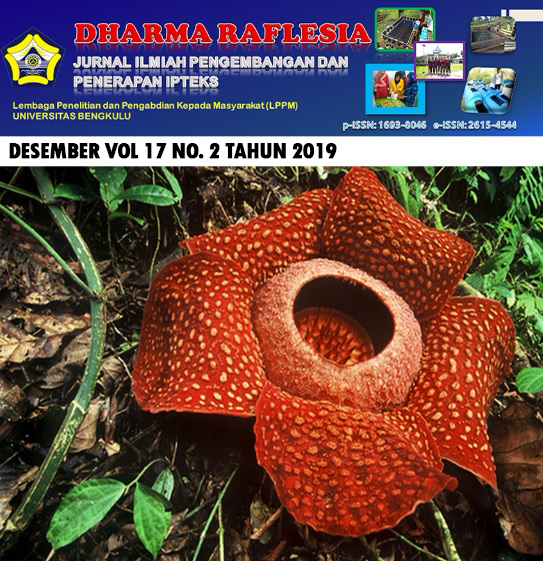Main Article Content
Abstract
This paper aims to discuss the training on the use of scaffolding talk in developing English language learning instruction for kindergarten teachers of Bengkulu City. The purpose of the training was to enhance the quality of the kindergarten teachers’ professional development.Followed by 20 kindergarten teachers of English, the training used the inductive participative training method was held in PAUD Intan Insani in Muara Bangkahulu of Bengkulu city on August 3, 2019. The training consisted of three phases: presenting the training materials, developing lesson plans, and practicing using the lesson plans in the classroom. This training was also the application of the books of Kiddos: An Integrated, Communicative and Character-based Material for Kindergarten Students, the outcome of the national research grant in 2005-2016. In this training, the teachers were trained to use the scaffolding talk in developing the instruction for learning English. The result show that the teachers are able to develop the lesson plans based on the chosen topics in the books but there is no video of the teaching practices in the classroom were submitted by the teachers yet. It could probably caused by many administrative tasks and activities they have to fulfil at schools. In addition, there is also the tendency among the teachers that they prefer a short training instead of the one which take three phases and long time to finish. Therefore, it is suggested to conduct a short training which takes one short time only and has not had many phases to be fulfilled.
Article Details
- Authors retain copyright and grant the journal right of first publication with the work simultaneously licensed under a Creative Commons Attribution-ShareAlike 4.0 (CC BY-SA) that allows others to share the work with an acknowledgement of the work's authorship and initial publication in this journal.
- Authors are able to enter into separate, additional contractual arrangements for the non-exclusive distribution of the journal's published version of the work (e.g., post it to an institutional repository or publish it in a book), with an acknowledgement of its initial publication in this journal.
- Authors are permitted and encouraged to post their work online (e.g., in institutional repositories or on their website) prior to and during the submission process, as it can lead to productive exchanges, as well as earlier and greater citation of published work (See The Effect of Open Access).
- This work is licensed under a Creative Commons Attribution-ShareAlike 4.0 International License.
References
- Alber, R. (2014). Scaffolding Strategies to Use with Your Students.(online) https://www.edutopia.org/blog/scaffolding-lessons-six-strategies-rebecca-alber
- Clarke, P. (2000). Language development and Identity. Keynote Paper, London University Conference: Supporting identity and language in the early years, London, UK.
- Copple, C., & Bredekamp, S. (2009). Developmentally appropriate practice in early childhood programs. Washington, DC: National Association for the Education of Young Children.
- Kamil, M. (2018). Model-Model Pelatihan diakses tanggal 4 April 2019 dari https://www.academia.edu/6077358/MODEL-MODEL_PELATIHAN_Oleh_Mustofa_Kamil
- Kemendiknas.(2004). Scaffolding Talk dalam Pembelajaran Bahasa Inggris.Modul Pelatihan Terintegerasi TOT Kurikulum 2004.
- Pentimonti, J.& M. Justice, L. (2010). Teachers’ Use of Scaffolding Strategies During Read Alouds in the Preschool Classroom. Early Childhood Education Journal. 37. 241-248. 10.1007/s10643-009-0348-6.
- Vygotsky, L. S. (1978). Mind in society: The development of higher psychological processes. Cambridge, MA: Harvard University Press.
- Yunita, W. & Hati, G.M. (2016). Teaching English for Kindergarten: Problems and Needs from Teacers’ Perspectives. Proceedings ELTeaM Celebrating Students’ Engagement.pp 81-89.
References
Alber, R. (2014). Scaffolding Strategies to Use with Your Students.(online) https://www.edutopia.org/blog/scaffolding-lessons-six-strategies-rebecca-alber
Clarke, P. (2000). Language development and Identity. Keynote Paper, London University Conference: Supporting identity and language in the early years, London, UK.
Copple, C., & Bredekamp, S. (2009). Developmentally appropriate practice in early childhood programs. Washington, DC: National Association for the Education of Young Children.
Kamil, M. (2018). Model-Model Pelatihan diakses tanggal 4 April 2019 dari https://www.academia.edu/6077358/MODEL-MODEL_PELATIHAN_Oleh_Mustofa_Kamil
Kemendiknas.(2004). Scaffolding Talk dalam Pembelajaran Bahasa Inggris.Modul Pelatihan Terintegerasi TOT Kurikulum 2004.
Pentimonti, J.& M. Justice, L. (2010). Teachers’ Use of Scaffolding Strategies During Read Alouds in the Preschool Classroom. Early Childhood Education Journal. 37. 241-248. 10.1007/s10643-009-0348-6.
Vygotsky, L. S. (1978). Mind in society: The development of higher psychological processes. Cambridge, MA: Harvard University Press.
Yunita, W. & Hati, G.M. (2016). Teaching English for Kindergarten: Problems and Needs from Teacers’ Perspectives. Proceedings ELTeaM Celebrating Students’ Engagement.pp 81-89.
